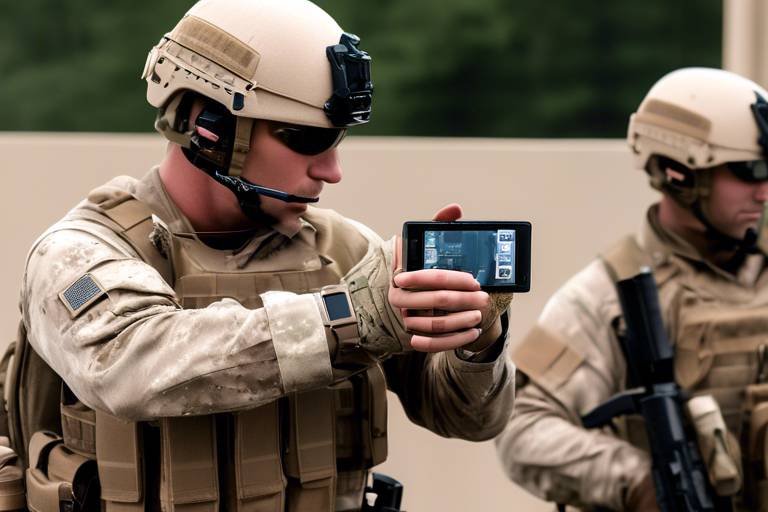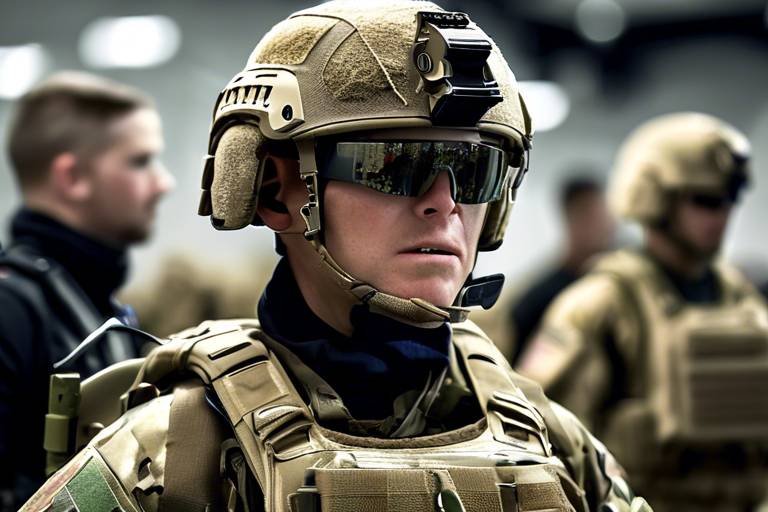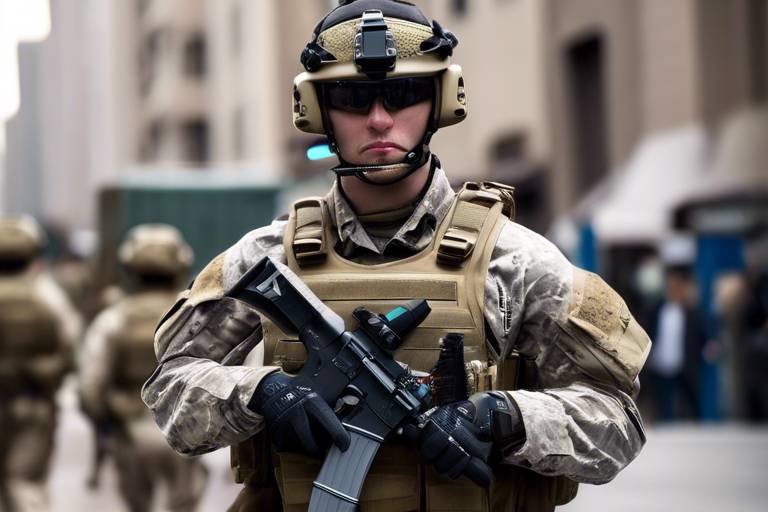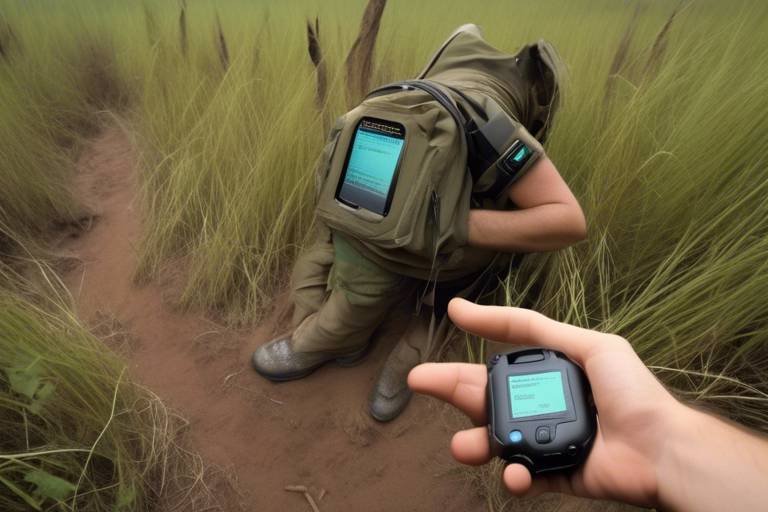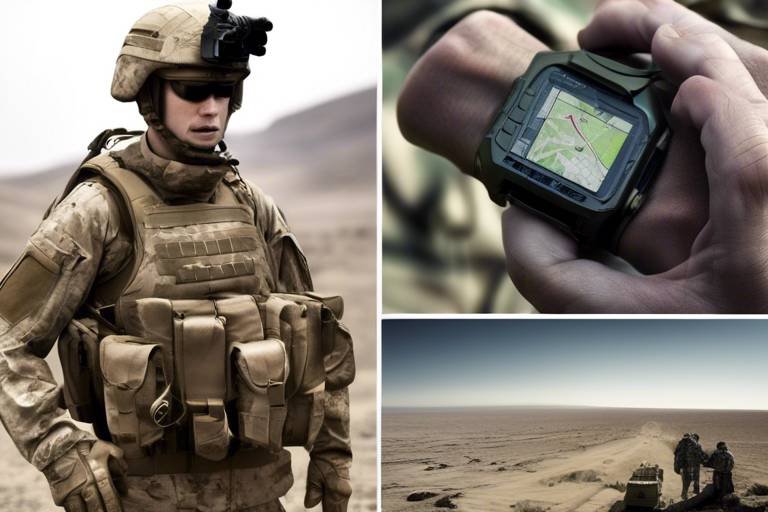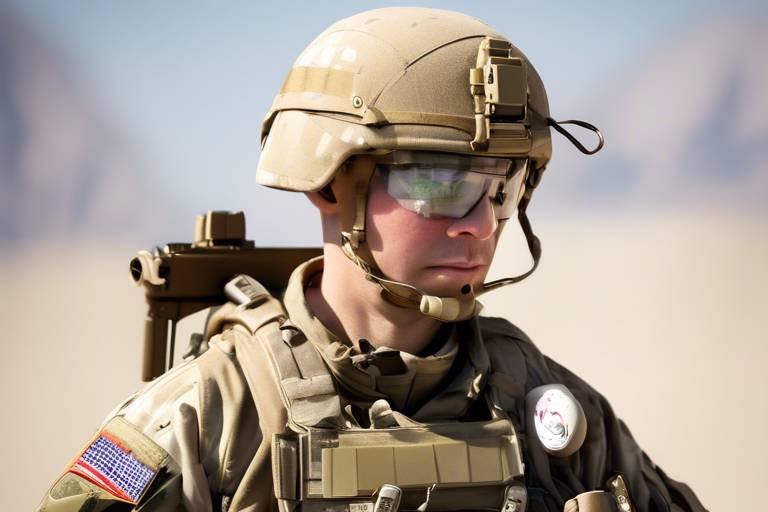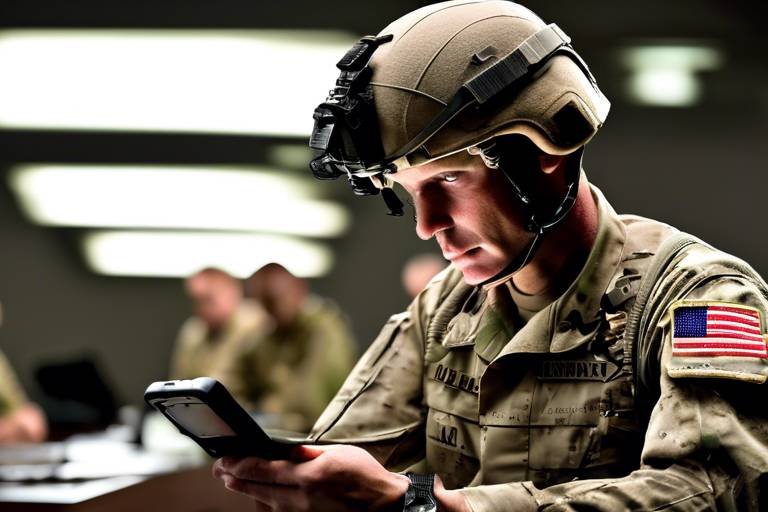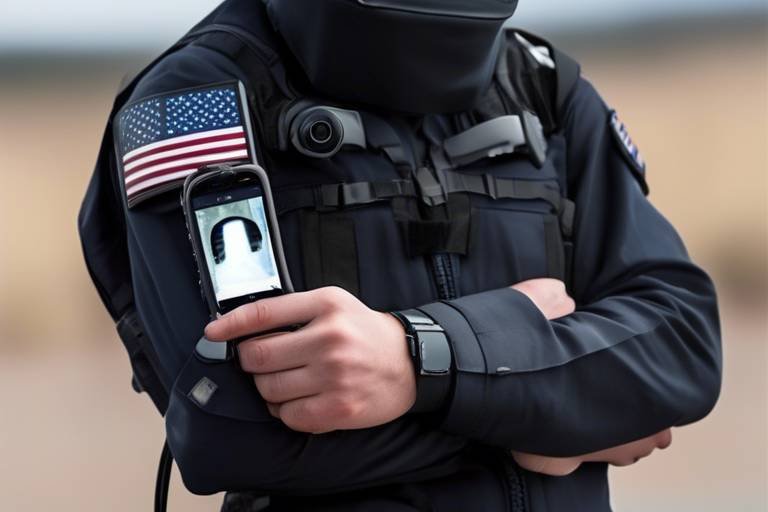The Role of Wearables in Enhancing Tactical Communication
In today's fast-paced world, wearable technology is not just a trend; it's a game-changer, especially in fields where effective communication can mean the difference between success and failure. From military operations to emergency response scenarios, wearables are stepping up the game by providing real-time data, improving coordination, and enhancing safety. Imagine a soldier in the field who can access critical information without fumbling for a device, or a first responder who can monitor vital signs while navigating through chaos. This article dives deep into how these innovations are revolutionizing tactical communication.
Wearable devices, such as smartwatches and fitness trackers, have evolved significantly over the years. They are no longer just about tracking steps or heart rates; they are now equipped with advanced functionalities tailored for high-stakes environments. For instance, some wearables come with integrated sensors that can monitor environmental conditions, while others offer GPS capabilities that allow for precise location tracking. This is crucial in tactical situations where every second counts.
One of the most significant benefits of wearables is their ability to provide real-time data transmission. In tactical scenarios, having immediate access to information can dramatically enhance decision-making and response times. Consider a scenario where a team is navigating through unfamiliar terrain. With wearables, they can receive updates about potential threats, weather changes, or even the health status of team members, all at their fingertips. This immediate access to information not only boosts efficiency but also enhances overall safety.
Furthermore, wearables significantly improve situational awareness. For military and emergency response teams, knowing what's happening around them is essential. Wearable devices can alert users to changes in their environment, providing vital information that helps them make informed decisions. For example, a firefighter wearing a smart helmet can receive real-time updates about smoke density and temperature fluctuations, allowing them to adapt their strategy on the fly.
Another exciting feature of wearables is GPS and location tracking. This technology enables teams to coordinate their movements effectively, ensuring that everyone is on the same page, even in unfamiliar terrains. Imagine a search and rescue operation where team members can see each other's locations on a map in real-time. This level of coordination is invaluable in high-pressure situations where every minute matters.
Moreover, wearables come equipped with health monitoring features that can track vital signs such as heart rate, oxygen levels, and more. In tactical environments, where physical and mental strain is high, these features can be lifesaving. For instance, if a team member's heart rate spikes unexpectedly, it could indicate a medical emergency, prompting immediate action. This proactive approach to health monitoring can prevent potentially dangerous situations from escalating.
However, the integration of wearables into tactical communication is not without its challenges. Issues like connectivity, battery life, and the need for user training can pose significant hurdles. For example, in remote areas where network coverage is spotty, maintaining a stable connection can be difficult. Similarly, the battery life of wearable devices can be a concern, especially during extended missions. To mitigate these issues, teams must invest in training to ensure that all members are proficient in using these devices effectively.
As we look toward the future, the potential for wearables in tactical communication is incredibly promising. With ongoing advancements in technology, we can expect to see even more innovative features that enhance operational efficiency. Imagine wearables that not only communicate but also analyze data in real-time, providing insights that can guide tactical decisions. The possibilities are endless, and as these technologies continue to evolve, they will undoubtedly reshape how teams operate in high-stakes environments.
- What types of wearables are used in tactical communication? Wearables can include smartwatches, health monitors, and specialized tactical devices designed for military and emergency response teams.
- How do wearables improve situational awareness? They provide real-time alerts and updates about environmental conditions, helping users stay informed and make better decisions.
- What are the main challenges in implementing wearables? Key challenges include connectivity issues, battery life concerns, and the need for user training to maximize effectiveness.
- What is the future of wearables in tactical communication? The future looks bright, with advancements expected to enhance features like data analysis and integration with existing systems.
Understanding Wearable Technology
Wearable technology is more than just a trend; it's a revolution that is changing the way we interact with the world around us. Imagine a device that you can wear on your wrist or even integrated into your clothing, providing you with real-time data and insights. This technology encompasses a wide range of devices, including smartwatches, fitness trackers, and even specialized gear designed for tactical environments.
In tactical scenarios, wearables serve a critical role. They are not just about tracking steps or heart rates; they are about enhancing operational efficiency and ensuring safety in high-stakes situations. For instance, smart helmets equipped with augmented reality can provide soldiers with vital information without taking their eyes off the battlefield. Similarly, smart glasses can relay real-time data to emergency responders, allowing them to make quick decisions that could save lives.
Let's break down the types of wearable technology commonly used in tactical settings:
- Smartwatches: These devices offer notifications, health monitoring, and GPS capabilities, making them versatile tools for communication and navigation.
- Fitness Trackers: While often used for personal health, these devices can monitor vital signs and physical performance, vital for ensuring team member readiness.
- Smart Clothing: This includes garments embedded with sensors that can monitor physiological data, which is particularly useful in military operations.
- Augmented Reality Devices: These allow users to visualize data in their field of view, enhancing situational awareness.
Each type of wearable technology comes with its own set of functionalities tailored for specific needs. For example, a smartwatch might alert a soldier to incoming communications while also tracking their heart rate, ensuring they remain aware of both their surroundings and their physical condition. On the other hand, augmented reality devices can overlay critical information directly onto the user’s field of vision, providing a seamless experience that integrates data with real-world scenarios.
As we explore the role of wearables in tactical communication, it becomes clear that they are not merely gadgets; they are essential tools that enhance coordination, efficiency, and ultimately, safety in environments where every second counts. The ability to access and relay information instantaneously can mean the difference between success and failure in high-pressure situations. Thus, understanding the capabilities and potential of wearable technology is crucial for anyone involved in tactical operations.
The Importance of Real-Time Data
In the fast-paced world of tactical operations, real-time data is not just a luxury; it's a necessity. Imagine being in a high-stakes situation where every second counts. The ability to access crucial information in the blink of an eye can mean the difference between success and failure. Wearable technology plays a pivotal role in ensuring that teams have immediate access to the data they need, right when they need it. This capability enhances decision-making processes and significantly improves response times in critical moments.
Consider a scenario where a search and rescue team is deployed in a disaster-stricken area. With wearables equipped to transmit real-time data, team members can share their locations, environmental conditions, and even health metrics instantaneously. This seamless flow of information allows for better coordination and more effective strategies. The integration of wearables into operational frameworks enables teams to adapt quickly to changing situations, ensuring that they can react to threats or emergencies without delay.
Furthermore, the significance of real-time data extends beyond just immediate access. It encompasses the ability to analyze trends and patterns as they unfold. For instance, in military operations, commanders can monitor troop movements and adjust tactics based on live data feeds. This dynamic approach to warfare can lead to more successful missions, as decisions are based on the latest information rather than outdated reports. The importance of real-time data cannot be overstated; it is a fundamental component that drives efficiency and effectiveness in tactical communication.
To illustrate the impact of real-time data in tactical scenarios, consider the following table that highlights key benefits:
| Benefit | Description |
|---|---|
| Faster Decision-Making | Instant access to data allows teams to make informed decisions quickly. |
| Enhanced Coordination | Real-time communication fosters better teamwork and collaboration. |
| Increased Safety | Immediate data sharing helps identify hazards and mitigate risks. |
| Adaptive Strategies | Teams can pivot their tactics based on live feedback and conditions. |
In summary, the role of real-time data in tactical communication is transformative. It empowers teams with the information they need to operate effectively, ensuring that they can navigate complex environments with confidence. As technology continues to evolve, the integration of real-time data into wearables will undoubtedly enhance the capabilities of tactical teams across various fields.
- What types of data can wearables transmit in real-time? Wearables can transmit various types of data, including location, health metrics, and environmental conditions.
- How do wearables enhance decision-making in tactical scenarios? By providing immediate access to critical information, wearables allow teams to make informed decisions quickly and efficiently.
- What are the potential risks associated with real-time data transmission? Risks include data breaches and connectivity issues, which can compromise the security and reliability of the information shared.
- Can wearables be integrated with existing communication systems? Yes, integrating wearables with current systems can enhance operational efficiency, although it may require careful planning and training.
Improved Situational Awareness
In today's fast-paced world, where every second can make a difference between success and failure, is not just a luxury; it's a necessity. Wearable technology plays a pivotal role in enhancing this awareness, especially in high-stakes environments such as military operations, emergency response, and law enforcement. Imagine being in a chaotic situation where decisions must be made swiftly—this is where wearables come to the rescue. They provide real-time data and critical information that can significantly alter the outcome of an operation.
One of the standout features of wearables is their ability to deliver vital information directly to the user's wrist or field of vision. This capability ensures that team members are not just reacting to situations but are also proactively managing them. For instance, a soldier on the battlefield can receive updates about enemy movements, weather conditions, or even health metrics of fellow team members without needing to check a bulky device or rely on verbal communication. This seamless flow of information is akin to having a personal assistant who is always one step ahead, allowing for a more coordinated and efficient response.
Moreover, wearables equipped with advanced sensors can detect environmental changes, alerting users to potential dangers such as gas leaks, extreme temperatures, or hazardous materials. This feature is especially crucial for emergency responders who often operate in unpredictable environments. By providing alerts and guidance, wearables not only enhance individual safety but also contribute to the overall effectiveness of the team. In essence, they act as a digital safety net, ensuring that no one is left in the dark.
To illustrate the impact of wearables on situational awareness, consider the following table that highlights key benefits:
| Benefit | Description |
|---|---|
| Real-Time Updates | Instant notifications about critical changes in the environment or mission parameters. |
| Enhanced Decision-Making | Access to vital data enables quicker and more informed decisions. |
| Team Coordination | Improved communication fosters better teamwork and reduces miscommunication. |
| Health Monitoring | Continuous tracking of vital signs ensures that team members are fit for duty. |
In summary, wearables are revolutionizing the way teams perceive and respond to their environments. By enhancing situational awareness, these devices empower users to make informed decisions swiftly, ensuring safety and operational success. The integration of such technology into tactical scenarios not only increases efficiency but also provides a significant edge in high-pressure situations. As we continue to innovate, the potential for wearables to further enhance situational awareness is boundless, making them an indispensable tool for those who operate in the field.
- What types of wearables are commonly used in tactical communication?
Wearables such as smartwatches, body cameras, and health monitors are commonly used to enhance communication and situational awareness in tactical settings. - How do wearables improve decision-making in critical situations?
By providing real-time data and alerts, wearables allow users to make informed decisions quickly, reducing response times and improving outcomes. - Are there any privacy concerns with using wearables?
Yes, the data collected by wearables can raise privacy concerns, especially if sensitive information is transmitted without proper security measures. - Can wearables be integrated with existing communication systems?
Yes, many wearables are designed to integrate seamlessly with current communication systems, enhancing overall operational efficiency.
GPS and Location Tracking
GPS and location tracking are game-changers in the realm of tactical communication. Imagine being in a high-stakes environment, where every second counts, and your team’s safety hinges on knowing exactly where everyone is. That’s where GPS technology shines! By integrating GPS into wearables, teams can achieve unparalleled precision in coordinating movements and ensuring safety, especially in unfamiliar or hostile terrains.
When a team is deployed for a mission, they often find themselves navigating complex landscapes that can change rapidly. With GPS-enabled wearables, each member can have real-time access to their location and the locations of their teammates. This capability not only enhances team coordination but also builds a sense of trust among members, knowing that they are never truly alone, even in the thick of chaos.
Furthermore, the ability to track locations can drastically improve response times in emergencies. For instance, if a team member is injured or in distress, others can quickly locate them using their wearable devices. This immediate access to location data can mean the difference between life and death. It’s like having a digital map that updates in real-time, guiding you through the fog of uncertainty.
In addition to enhancing safety and coordination, GPS technology can also provide valuable data for post-mission analysis. By reviewing the paths taken and the locations of key events, teams can refine their strategies for future operations. This data-driven approach allows for continuous improvement, ensuring that each mission is executed more effectively than the last.
However, it’s essential to recognize that with great power comes great responsibility. The integration of GPS technology also raises concerns about privacy and security. Teams must ensure that the data transmitted is protected from unauthorized access. This is especially critical in tactical environments where sensitive information can be exploited by adversaries.
In summary, GPS and location tracking are not just technological enhancements; they are vital tools that empower teams to operate efficiently and safely in high-pressure situations. As wearable technology continues to evolve, we can expect even more innovative features that will further revolutionize tactical communication.
Health Monitoring Features
In the high-stakes world of tactical operations, every second counts, and the health of team members is paramount. Wearable technology has stepped up to the plate, offering that can be crucial in preventing medical emergencies. Imagine you're in the middle of a mission, adrenaline pumping, and suddenly, one of your team members starts feeling unwell. With wearables equipped to track vital signs—like heart rate, blood pressure, and even oxygen saturation—you can instantly assess their condition without breaking the flow of the operation.
These devices continuously monitor health metrics, providing real-time feedback that can alert users to any irregularities. For example, if a soldier's heart rate spikes unexpectedly, the wearable can send an alert, prompting immediate action. This feature is not just about individual health; it enhances team safety as well. When everyone is aware of their health status, it fosters a culture of vigilance and preparedness.
Moreover, many wearables can sync with mobile devices or central command systems, allowing for seamless communication of health data. This integration means that medical personnel can monitor the health of team members remotely, ensuring that help can be dispatched quickly if needed. The ability to access this data in real-time can be the difference between life and death in critical situations.
To illustrate the importance of these health monitoring features, consider the following table that outlines some key functionalities:
| Health Metric | Functionality | Importance in Tactical Scenarios |
|---|---|---|
| Heart Rate Monitoring | Tracks beats per minute | Detects stress or exertion levels |
| Blood Pressure Monitoring | Measures systolic and diastolic pressure | Identifies potential health risks |
| Oxygen Saturation | Monitors blood oxygen levels | Critical for assessing respiratory health |
| Temperature Monitoring | Tracks body temperature | Detects fever or hypothermia |
In summary, the health monitoring features of wearables are not just technological novelties; they are essential tools that enhance the safety and effectiveness of tactical operations. By providing critical health data in real-time, these devices empower teams to make informed decisions, ensuring that every member is in peak condition to face the challenges ahead.
- What types of health metrics can wearables track? Most wearables can track heart rate, blood pressure, oxygen saturation, and body temperature.
- How do wearables enhance team safety? By monitoring health metrics in real-time, wearables can alert team members to potential health issues, allowing for immediate intervention.
- Can health data from wearables be shared with medical personnel? Yes, many wearables can sync with mobile devices or central systems, enabling health data sharing with medical teams.
- Are wearables reliable in extreme conditions? Many modern wearables are designed to be durable and function effectively in various environmental conditions, making them suitable for tactical use.
Enhanced Communication Capabilities
In the fast-paced world of tactical operations, communication is often the difference between success and failure. Wearable technology has emerged as a game-changer in this arena, providing team members with the ability to communicate seamlessly, even in the most challenging environments. Imagine being in a high-stakes situation where every second counts; having a device that allows you to relay critical information instantly can be a lifesaver. Wearables come equipped with various communication features that enhance collaboration and coordination among team members.
One of the standout features of these devices is their ability to facilitate voice communication through integrated microphones and speakers. This means that team members can communicate hands-free, allowing them to focus on their tasks without the distraction of handling a phone or radio. For instance, a soldier on the field can receive commands or updates without needing to stop what they are doing, maintaining their situational awareness while staying connected. Additionally, many wearables support push-to-talk functionality, which mimics traditional walkie-talkies, allowing for quick and efficient communication.
Moreover, wearables often come with advanced messaging capabilities, enabling users to send text messages or alerts even in areas with low connectivity. This feature is particularly useful in situations where voice communication might not be feasible due to noise or other environmental factors. The ability to send short, concise messages can keep everyone in the loop, ensuring that no vital information is lost in the chaos. Some devices also support group messaging, allowing entire teams to receive updates simultaneously, which is crucial for maintaining a unified front in tactical scenarios.
Another exciting aspect of wearables is their integration with augmented reality (AR) technology. Imagine wearing a headset that overlays critical information directly into your field of vision. This feature can provide real-time updates, such as enemy locations or mission objectives, directly in front of you, enhancing both communication and situational awareness. The combination of AR and wearables means that team members can receive information without taking their eyes off the task at hand, making it a powerful tool for tactical teams.
Furthermore, the data collected by wearables can be analyzed and shared with command centers, providing a comprehensive view of the operation. This means that decision-makers can have access to real-time data from the field, allowing them to make informed choices quickly. In situations where every second counts, having accurate information can be the key to a successful operation.
In summary, the offered by wearable technology are revolutionizing how teams operate in tactical environments. By providing seamless voice communication, advanced messaging, and integration with AR, wearables ensure that team members stay connected, informed, and ready to act. As technology continues to evolve, we can expect these capabilities to become even more sophisticated, further improving coordination and safety in high-stakes situations.
Challenges in Implementing Wearables
While the advantages of wearable technology in tactical communication are undeniable, the road to full implementation is not without its bumps. Think of it like trying to navigate through a dense fog; you know there’s a clear path ahead, but the visibility is limited, making every step feel uncertain. One of the primary challenges is connectivity. In high-stakes environments, reliable internet and cellular connections are often hard to come by, which can hinder the effectiveness of wearables. Imagine being in a situation where your device loses signal just when you need it the most; it’s a nightmare scenario for any team relying on real-time data.
Another significant hurdle is battery life. Wearables are designed to be lightweight and compact, but this often comes at the expense of longevity. In critical missions, the last thing you want is for your device to run out of juice. It’s like having a flashlight that flickers and dies just when you’re about to explore a dark cave. Teams must strategize around battery management, ensuring that devices are charged and ready for action at all times.
Furthermore, user training is essential for maximizing the potential of these devices. Many team members may not be tech-savvy or familiar with the latest technology. If they don’t know how to operate the wearable effectively, its benefits will be lost. This brings us to a crucial point: the importance of comprehensive training programs. It's not just about handing out devices; it’s about empowering users to leverage the technology to its fullest. Consider this: if you were given a high-end sports car but had no idea how to drive it, would you feel safe taking it for a spin? Exactly.
Finally, we must address the elephant in the room: data security concerns. With increased connectivity comes the risk of data breaches, which can have dire consequences in tactical scenarios. Sensitive information transmitted by wearables must be safeguarded against potential cyber threats. It’s like having a treasure chest filled with valuable information; if it’s not locked up tight, someone might just take it. Organizations need to implement robust security measures to protect against these vulnerabilities, ensuring that their data remains confidential and secure.
To summarize, the implementation of wearable technology in tactical communication faces several challenges, including:
- Connectivity Issues: Difficulty in maintaining reliable connections in high-stakes environments.
- Battery Life: The need for longer-lasting devices during critical missions.
- User Training: Ensuring team members are proficient in using the technology.
- Data Security: Protecting sensitive information from potential breaches.
Despite these challenges, the potential benefits of wearables in enhancing tactical communication far outweigh the obstacles. With continued advancements in technology and a focus on overcoming these issues, the future looks bright for wearables in various high-stakes environments.
- What are the primary benefits of wearable technology in tactical communication? Wearables enhance real-time data access, improve situational awareness, and facilitate better communication among team members.
- How can organizations address the challenges of implementing wearables? By focusing on connectivity solutions, investing in user training, and prioritizing data security measures.
- Are there specific industries that benefit more from wearables? Yes, industries such as military, emergency response, and healthcare see significant improvements in efficiency and safety through wearable technology.
Data Security Concerns
As the integration of wearable technology into tactical communication systems accelerates, the issue of data security becomes increasingly pressing. With devices that constantly collect and transmit sensitive information, the risk of data breaches rises significantly. Imagine a scenario where crucial tactical data falls into the wrong hands; the consequences could be dire, potentially compromising missions and endangering lives.
Wearable devices, while incredibly beneficial, often operate on networks that can be vulnerable to hacking. Attackers might exploit these vulnerabilities to gain unauthorized access to sensitive information, including location data, health metrics, and communication logs. This not only poses a threat to the individuals using these devices but also to the integrity of entire operations. For instance, if a military unit's location data is intercepted, it could lead to ambushes or other dangerous situations.
To mitigate these risks, organizations must prioritize robust security protocols when implementing wearable technology. This includes using encryption to protect data in transit and at rest. Additionally, regular software updates and patches are essential to address any emerging vulnerabilities. It's crucial for teams to adopt a comprehensive approach to security that includes:
- Strong Authentication: Implementing multi-factor authentication can significantly reduce the risk of unauthorized access.
- Data Encryption: Encrypting sensitive data ensures that even if it is intercepted, it remains unreadable to unauthorized users.
- Regular Security Audits: Conducting frequent audits can help identify and rectify potential security weaknesses in the system.
Moreover, user training plays a vital role in enhancing data security. Team members must be educated about the potential risks associated with wearable devices and the best practices for safeguarding their data. This includes being aware of phishing attempts and understanding how to recognize suspicious activity.
In conclusion, while the advantages of wearables in tactical communication are undeniable, addressing data security concerns is paramount. Organizations must take a proactive stance to protect sensitive information and ensure that the benefits of these technologies are not overshadowed by the risks they pose.
- What types of data do wearables collect? Wearables can collect a variety of data, including location, health metrics (like heart rate and activity levels), and communication logs.
- How can organizations protect sensitive data transmitted by wearables? Organizations can implement strong authentication, data encryption, and regular security audits to protect sensitive information.
- What are the risks of using wearables in tactical environments? Risks include data breaches, unauthorized access to sensitive information, and potential misuse of location data.
- Is user training important for wearable security? Yes, educating users about security risks and best practices is essential to protect data and ensure safe usage of wearable technology.
Integration with Existing Systems
Integrating wearable technology with existing communication systems is no small feat. It's akin to trying to fit a square peg into a round hole—there are challenges and complexities that need to be navigated. First and foremost, the compatibility of these devices with current infrastructure is crucial. Many organizations rely on legacy systems that may not easily accommodate the latest wearable technology. Therefore, a comprehensive assessment of both hardware and software capabilities is essential.
Moreover, the integration process often requires a collaborative effort among various stakeholders, including IT professionals, operational teams, and the manufacturers of the wearable devices. This collaboration is vital to ensure that the wearables can communicate effectively with existing platforms. For instance, if a team is using a specific communication app, the wearables must be able to send and receive data through that app seamlessly.
Another significant aspect to consider is the training of personnel. Even the most advanced technology is only as effective as the people using it. Therefore, organizations must invest time and resources into training their teams on how to utilize these wearables effectively. This training should cover not only the technical aspects but also practical scenarios where the wearables can enhance operational efficiency.
To illustrate the integration process, here’s a simple table that outlines key considerations:
| Consideration | Description |
|---|---|
| Compatibility | Assessing whether existing systems can support new wearable technology. |
| Collaboration | Engaging stakeholders from various teams for successful integration. |
| Training | Providing comprehensive training for users to maximize the benefits of wearables. |
In conclusion, while the integration of wearables into existing systems presents challenges, it also opens doors to unprecedented efficiency and effectiveness in tactical communication. By addressing compatibility issues, fostering collaboration, and prioritizing user training, organizations can leverage the full potential of wearable technology to enhance their operational capabilities.
- What types of wearables are best for tactical communication? Wearables that offer real-time data transmission, GPS tracking, and health monitoring features are ideal for tactical scenarios.
- How can organizations ensure data security with wearables? Implementing robust encryption methods and regular security audits can help safeguard sensitive information.
- What are the common challenges in integrating wearables? Issues such as compatibility with existing systems, user training, and ensuring reliable connectivity can pose challenges.
The Future of Wearables in Tactical Communication
As we look ahead, the future of wearable technology in tactical communication is not just bright; it’s positively dazzling! Imagine a world where every soldier, firefighter, and emergency responder is equipped with cutting-edge devices that not only enhance their capabilities but also keep them connected in real-time. The integration of advanced artificial intelligence and machine learning into wearables is set to redefine how we approach tactical scenarios. These devices will evolve from simple health monitors to sophisticated systems that can predict and respond to the needs of the user.
One of the most exciting prospects is the development of augmented reality (AR)
Furthermore, as wearables become more integrated with the Internet of Things (IoT), the potential for interoperability among various devices will explode. This means that wearables will communicate seamlessly with drones, vehicles, and other equipment, creating a cohesive network that enhances operational efficiency. Imagine a scenario where a drone can relay real-time video feeds to a wearable device, providing critical visual information to ground teams. The synergy of these technologies will create a tactical ecosystem that is responsive, adaptive, and incredibly effective. However, with great power comes great responsibility. The future of wearables will also necessitate a robust framework for data security. As these devices become more prevalent, the amount of sensitive information they handle will increase exponentially. Ensuring that this data is protected from cyber threats will be paramount. Organizations will need to invest in advanced cybersecurity measures and protocols to safeguard the information transmitted and received by these wearables. In summary, the future of wearables in tactical communication is poised for a revolution. With the convergence of technologies like AR, IoT, and AI, we are on the brink of a new era where tactical teams can operate with unprecedented efficiency and safety. The possibilities are endless, and the only limit is our imagination. As we embrace these advancements, we must also prioritize security to ensure that the benefits of wearable technology are realized without compromising the integrity of our operations. Wearable technologies refer to devices like smartwatches, fitness trackers, and specialized gear designed to monitor health metrics and enhance communication in tactical scenarios. These devices are crucial for teams operating in high-stakes environments, as they provide real-time data and improve situational awareness. Wearables enhance situational awareness by providing users with vital information about their surroundings. For military and emergency response teams, this means having immediate access to critical data, including location and health metrics, which can significantly impact decision-making and response times. GPS integration in wearables allows for precise location tracking. This feature is essential for coordinating team movements, especially in unfamiliar terrains, ensuring that team members can navigate effectively and maintain safety during operations. Absolutely! Many wearables come equipped with health monitoring features that track vital signs such as heart rate, temperature, and even stress levels. This capability is particularly beneficial in tactical environments, as it helps prevent potential medical emergencies by alerting users to concerning changes in their health. Implementing wearables in tactical settings can pose several challenges, including connectivity issues, limited battery life, and the need for user training. These factors can affect the effectiveness of the devices and require careful planning and management to overcome. Data security is a significant concern with wearables due to the sensitive information they transmit. It's crucial to implement robust encryption methods, secure communication protocols, and regular software updates to protect against potential data breaches and ensure the safety of transmitted information. Integrating wearables with existing communication systems can be complex. However, with the right strategies—such as choosing compatible technologies and ensuring proper training—organizations can enhance operational efficiency and ensure seamless communication among team members. The future of wearables in tactical communication looks promising, with advancements expected in technology, functionality, and integration capabilities. As these devices continue to evolve, they will likely become even more essential in various industries, improving coordination and safety in high-pressure situations.
Frequently Asked Questions

